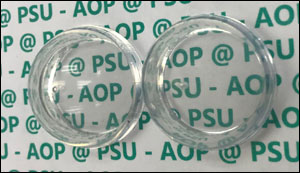Antireflection coating makes plastic invisible
30. 1. 2019 | Penn State | www.psu.edu
Antireflection (AR) coatings on plastics have a multitude of practical applications, including glare reduction on eyeglasses, computer monitors and the display on your smart-phone when outdoors. Now, researchers at Penn State have developed an AR coating that improves on existing coatings to the extent that it can make transparent plastics, such as Plexiglas, virtually invisible.
"This discovery came about as we were trying to make higher-efficiency solar panels," said Chris Giebink, associate professor of electrical engineering, Penn State. "We would have liked to find an off-the-shelf solution, but there wasn't one that met our performance requirements," he said. "So, we started looking for our own solution."

In a paper recently posted online ahead of print in the journal Nano Letters, Giebink and coauthors describe a new process to bridge the gap between Teflon and air. They used a sacrificial molecule to create nanoscale pores in evaporated Teflon, thereby creating a graded index Teflon-air film that fools light into seeing a smooth transition from 1 to 1.5, eliminating essentially all reflections.
One unexpected application is in high altitude UAVs, or unmanned aerial vehicles. Because the technology is compatible with current manufacturing techniques, Giebink believes the coating technology is scalable and widely applicable.
Read more at Penn State
Image Credit: Giebink Lab/Penn State
-jk-




